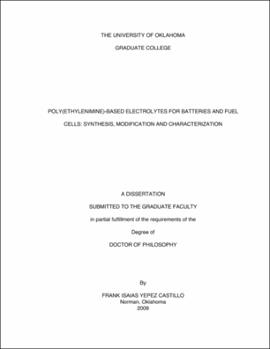| dc.contributor.advisor | Glatzhofer, Daniel T. | |
| dc.creator | Yepez Castillo, Frank Isaias | |
| dc.date.accessioned | 2019-04-27T21:28:13Z | |
| dc.date.available | 2019-04-27T21:28:13Z | |
| dc.date.issued | 2009 | |
| dc.identifier | 99214263002042 | |
| dc.identifier.uri | https://hdl.handle.net/11244/318764 | |
| dc.description.abstract | Poly(ethylenimine) (PEI) is an ion conducting polymer with great potential for applications in lithium batteries and proton exchange membrane fuel cells. Branched poly(ethylenimine) was N—methylated via an Eschweiler—Clarke reaction to produce branched poly(N—methylethylenimine), BPMEI. Novel alkylated linear poly(N—ethylethylenimine), LPEEI, and linear poly(N—butylethylenimine), LPBEI, were synthesized from linear poly(ethylenimine), LPEI, via reductive amination of aliphatic aldehydes. Differential scanning calorimetry was used to determine the glass transition temperature, Tg, of neat BPMEI (Tg = – 91°C), LPEEI (Tg = – 80°C) and LPBEI (Tg = – 50°C). Tgs of various N—alkylated PEI—lithium triflate complexes with different salt concentrations were determined. BPMEI exhibits a greater Tg change upon lithium triflate addition (from – 91°C to 13°C) than that of LPMEI complexes (from – 93°C to – 14°C). It was found that LPEEI complexes showed higher Tgs at all salt concentrations than the corresponding LPMEI—LiSO3CF3 system. IR and Raman spectroscopy were used to study complexes of these polymers with lithium triflate for battery applications. Vibrational spectra of BPMEI—LiSO3CF3 complexes reveal that aggregate formation is not observed until salt concentration reaches 5:1 (N:Li molar ratio). Additionally, a decrease in the relative concentration of “free” ions, compared to equivalent linear systems, is observed. LPEEI’s spectra presented few changes upon salt addition, suggesting that salt addition causes less disruption of the local polymer microstructure than that observed in LPMEI systems in previous studies. | |
| dc.description.abstract | Linear poly(ethylenimine) hydrochloride, LPEI·HCl, was successfully crosslinked using malonaldehyde generated in situ, and the degree of crosslinking was determined from the ratio of crosslink to polymer backbone hydrogens obtained using 1H NMR spectroscopy. The ionic conductivity is highest at intermediate degrees of crosslinking (ca. 0.45), approximately 1x10–3 S/cm at room temperature and 75% relative humidity. IR and Raman spectroscopy were used to characterize the crosslinked network. The presence of β—amino—ethenyliminium crosslink units can be identified through a series of bands between 1570 and 1640 cm&rdash;1. Ionic conductivity studies were performed on crosslinked LPEI·HCl as a function of relative humidity, degree of crosslinking, temperature and phosphoric acid content. Results showed that the dependence of the conductivity on these factors is complex and that it involves a drastic transition in which the conductivity increases by several orders of magnitude. The onset of this transition appears to be related to the composition of the polymer membranes. Membranes with ionic conductivities as high as 0.16 S/cm at 130°C and 20% RH were obtained. Crosslinked LPEI·HCl/H3PO4—based membranes were used in membrane electrode assemblies, MEAs, for proton exchange membranes fuel cells. MEAs were tested at temperatures ranging from 60 to 130°C and 30% RH. Upon comparison, LPEI—based MEAs exhibited better performance than Nafion® 117—based MEAs tested under the same conditions. PEI—based MEAs with 2.0 P:N and 0.66 degree of crosslinking produced 0.30 mA/cm2 at 0.38 V at 90°C and 30% RH. Nafion® 117—based MEAs produced 0.047 mA/cm2 at 0.34 V under the same conditions. | |
| dc.format.extent | 168 pages | |
| dc.format.medium | application.pdf | |
| dc.language | en_US | |
| dc.relation.requires | Adobe Acrobat Reader | |
| dc.subject | Polyelectrolytes | |
| dc.subject | Fuel cells | |
| dc.subject | Electric batteries | |
| dc.title | POLY(ETHYLENIMINE)-BASED ELECTROLYTES FOR BATTERIES AND FUEL CELLS: SYNTHESIS, MODIFICATION AND CHARACTERIZATION | |
| dc.type | text | |
| dc.type | document | |
| dc.thesis.degree | Ph.D. | |
| ou.group | College of Arts and Sciences::Department of Chemistry and Biochemistry | |
